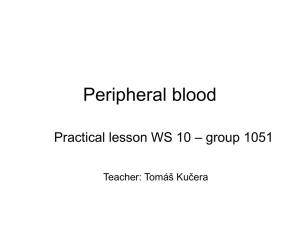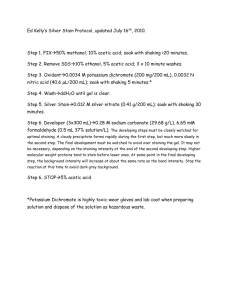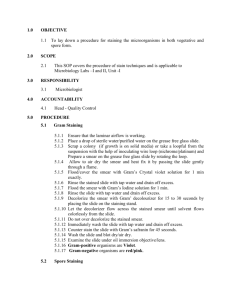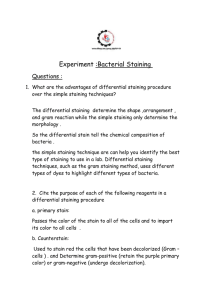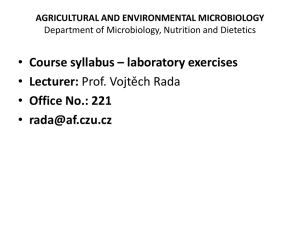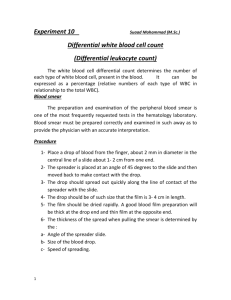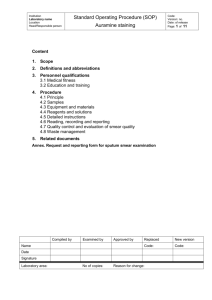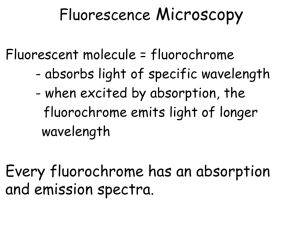Fluorescence Microscopy
advertisement
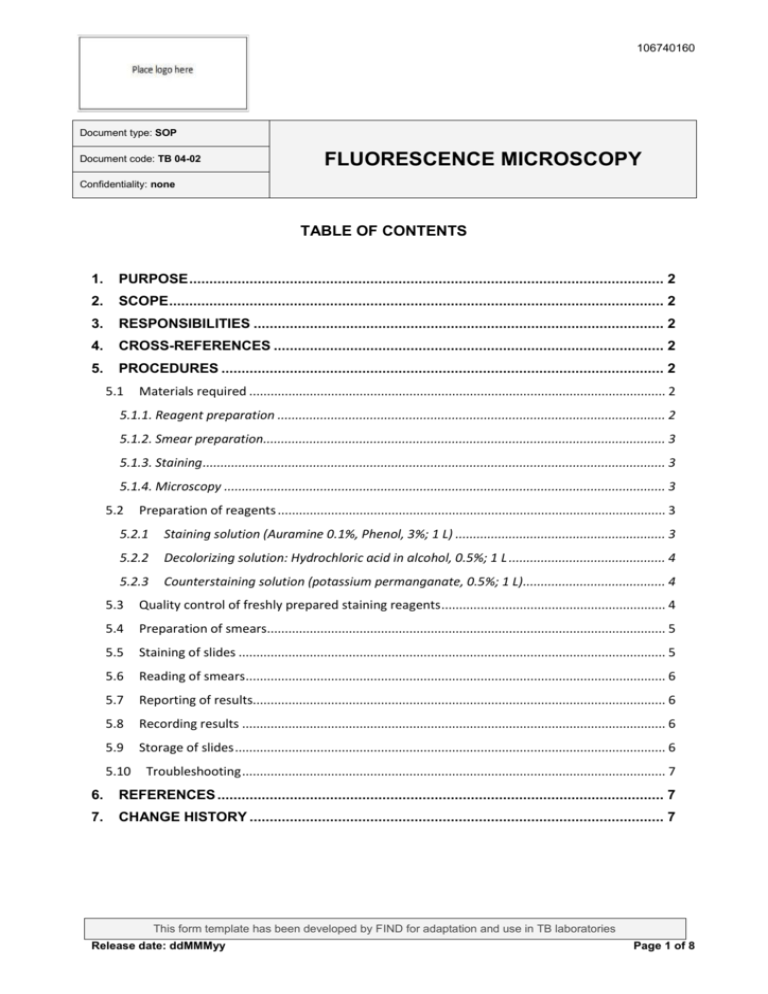
106740160 Document type: SOP Document code: TB 04-02 FLUORESCENCE MICROSCOPY Confidentiality: none TABLE OF CONTENTS 1. PURPOSE ...................................................................................................................... 2 2. SCOPE ........................................................................................................................... 2 3. RESPONSIBILITIES ...................................................................................................... 2 4. CROSS-REFERENCES ................................................................................................. 2 5. PROCEDURES .............................................................................................................. 2 5.1 Materials required ..................................................................................................................... 2 5.1.1. Reagent preparation ............................................................................................................. 2 5.1.2. Smear preparation................................................................................................................. 3 5.1.3. Staining .................................................................................................................................. 3 5.1.4. Microscopy ............................................................................................................................ 3 5.2 Preparation of reagents ............................................................................................................. 3 5.2.1 Staining solution (Auramine 0.1%, Phenol, 3%; 1 L) ........................................................... 3 5.2.2 Decolorizing solution: Hydrochloric acid in alcohol, 0.5%; 1 L ............................................ 4 5.2.3 Counterstaining solution (potassium permanganate, 0.5%; 1 L)........................................ 4 5.3 Quality control of freshly prepared staining reagents ............................................................... 4 5.4 Preparation of smears................................................................................................................ 5 5.5 Staining of slides ........................................................................................................................ 5 5.6 Reading of smears ...................................................................................................................... 6 5.7 Reporting of results.................................................................................................................... 6 5.8 Recording results ....................................................................................................................... 6 5.9 Storage of slides ......................................................................................................................... 6 5.10 Troubleshooting ....................................................................................................................... 7 6. REFERENCES ............................................................................................................... 7 7. CHANGE HISTORY ....................................................................................................... 7 This form template has been developed by FIND for adaptation and use in TB laboratories Release date: ddMMMyy Page 1 of 8 106740160 1. PURPOSE This SOP describes fluorescence acid-fast bacilli (AFB) microscopy in the _______________ TB Laboratory. The property of acid-fastness of mycobacteria is based on the presence of mycolic acid in their cell wall. Primary stain (Auramine) binds cell wall mycolic acids. Intense decolourization (strong acid) does not release primary stain from the cell wall easily and AFBs keep the fluorescent bright colour of Auramine. Counterstain (potassium permanganate) provides contrasting background. Fluorescent stains are usually organic substances which absorb ultraviolet light and remit part of the energy as light of longer wavelength which can be observed through the eyepiece as fluorescence. When exposed to ultraviolet light, the fluorescent bacilli are perceived as brightly coloured organisms against a dark background. 2. SCOPE This SOP covers microscopy procedures performed at the ____________________TB Laboratory. 3. RESPONSIBILITIES All staff members working in the ____________________TB Laboratory are responsible for the implementation of this operating procedure. All users of this procedure who do not understand it or are unable to carry it out as described are responsible for seeking advice from their supervisor. 4. CROSS-REFERENCES See: Document Matrix_TB 01_01_V1.0.doc Location: 5. PROCEDURES 5.1 Materials required 5.1.1. Reagent preparation Balance, with a sensitivity of 0.1 g Brushes to clean bottles before reuse Containers for the newly prepared stains (dark amber glass bottles or plastic bottles) Distilled or purified water Flasks (conical or flat-bottomed balloons), capacity at least one litre Measuring cylinders Labels for bottles Magnetic stirrer Auramine, certified grade Phenol crystals Alcohol (70% ethanol) Hydrochloric (37%, fuming) acid Distilled water Potassium Permanganate, certified grade Page 2 of 7 106740160 5.1.2. Smear preparation BSC Sharps container Biohazard bag for waste disposal New slides Pencil for frosted and diamond pencil for unfrosted slides Slides holder Wooden sticks or disposable loops 5.1.3. Staining Forceps Slides staining rack Timer 5.1.4. Microscopy Fluorescent microscope Len cleaning solution Lens cleaning paper 5.2 Preparation of reagents Stains used in the ____________________TB Laboratory will generally be purchased as preprepared reagents, where possible. However, in some circumstances (such as unavailability of commercial supplies), staining solutions will be prepared in the ____________________TB Laboratory. The following procedure for staining solution preparation will be followed: 5.2.1 Staining solution (Auramine 0.1%, Phenol, 3%; 1 L) Weigh 1.0 g of Auramine powder and 30 g of phenol crystals separately. Measure 100 ml of alcohol and 870 ml of distilled water separately. Combine alcohol and Auramine powder in a conical flask and stir until Auramine dissolved. Add phenol crystals to water and stir until dissolved. Only after Auramine is completely dissolved combine the two solutions. Top off with distilled water to fill to a total volume of 1 L. Perform Quality Control (see Section 5.5). If results of QC satisfactory label appropriate clean container for freshly prepared stain with: “0.1% Auramine”, batch number, date prepared, expiry date (shelf life of the stain 6 months) and initials. Date of first opening should be mentioned. Record prepared batch in the Fluorescence Stains Preparation Logbook. Use: Fluorescence Stains Prep Logbook_form.doc Location: Store in the dark Page 3 of 7 106740160 5.2.2 Add 995 ml of 70% alcohol to a conical flask. Carefully add 5 ml of concentrated hydrochloric acid into the flask containing alcohol, directing the flow of acid along the inner side of the flask with constant swirling. Mix well by swirling the flask. Perform Quality Control (see Section 5.5). If results of QC are satisfactory label appropriate clean container for freshly prepared stain with: “0.5% acid alcohol”, batch number, date prepared, expiry date (shelf life of the stain 6 months) and initials. Date of first opened should be mentioned. Record prepared batch in Fluorescence Stains Preparation Logbook (see above for location). 5.2.3 5.3 Counterstaining solution (potassium permanganate, 0.5%; 1 L) Weigh 5 g of potassium permanganate powder. Add the powder to 1 L of water. Swirl and stir until dissolved. Perform Quality Control (see Section 5.5). If results of QC are satisfactory, label appropriate clean container for freshly prepared stain with: “0.5% potassium permanganate”, batch number, date prepared, expiry date (shelf life of the stain 6 months) and initials. Date of first opened should be mentioned. Record prepared batch in Fluorescence Stains Preparation Logbook (see above for location). Store in the dark. Decolorizing solution: Hydrochloric acid in alcohol, 0.5%; 1 L Quality control of freshly prepared staining reagents Quality control must to be performed for each batch of staining, decolorizing and counterstaining solutions before using them routinely. Control slides include two known positive (1+) and two known negative slides. Stain positive control slides one time and negative control slides three times in raw (without reading) in order to check for the presence of environmental mycobacteria in water used for preparation of stains. Read all slides once. Record results of quality control in Quality control of Auramine Stains. Use: QC Auramine Stains_form.doc Location: Unacceptable results of quality control are as follows: AFBs in positive control slides are not bright yellow Negative control remains bright yellow after de-colorization Background is not properly de-colorized If there are unacceptable results: Check for the method of preparation of reagents. If preparation of staining solutions seems to be correct repeat a few more slides and ensure the staining procedure is correct. If no errors are found in stain preparation and staining procedure prepare new staining solutions from a new batch of stains and reagents: Page 4 of 7 106740160 o o 5.4 Auramine in case AFBs are not bright yellow De-colorization solution if negative control remains bright yellow after de-colorization and background of the slides not properly de-colorized. Preparation of smears Label the slide using a pencil or diamond pen using the laboratory number. Record laboratory numbers on the Auramine Microscopy Worksheet. Use: Auramine Microscopy Worksheet_form.doc Location: 5.5 Place the slide on the slide holder Procedure for smear preparation: For a direct sputum smear select a small potion of purulent or mucopurulent material to the slide with a stick /loop and transfer it to the slide. If the smear is to be done after specimen decontamination or liquid culture, transfer one drop of the material to the slide with a sterile pipette or tip used for media inoculation. Do not splash. Albumin can be used to help specimen stick to slide. For smear to be done from culture on solid media put one drop of sterile saline on the slide and transfer a very small growth with sterile loop into the drop and gently rub it. Spread the material carefully over the area equal to about 1-2cm,do not touch the border and take care to avoid placing too much on the slide, the thickness of smear should be such that a newspaper can be read through the smear if held under the slide The slide bearing the smear should be left to dry in air at room temperature. As soon as they are dry, hold the slide with forceps and fix them by passing them through a Bunsen burner or spirit flame three times in a quick succession. Staining of slides Include QC slides with each days reading Place the slide on the staining rack over a sink. Keep distance in between slides otherwise there is a possibility that acid-fast bacilli might float off one slide and become attached to the next slide. Pour Auramine solution over the slide to that the smear is completely covered. Do not heat. Leave for 20 minutes. Thoroughly rinse the slide with distilled water. Chlorine present in tap water can interfere with fluorescence. Pour the acid solution over the slides. Allow for to act 3 minutes. Gently rinse again with distilled until all macroscopically visible stain has been washed off. Flood smear with potassium permanganate solution for 1minute (proper timing is critical because counterstaining for longer time may quench the fluorescence). Wash off with distilled water. Stand the slide on edge to drain. Air dry on slide rack. Page 5 of 7 106740160 5.6 Reading of smears Start reading with QC slides. The positive control ensures the staining capability of the solutions and of the staining procedure. The negative control confirms that acid-fast contaminants are not present in the stains and in other solutions. Use 25x or 40x objective together with 10x. Systematically examine the smear by scanning it in the horizontal direction and move back (at least 100 fields are to be examined before smear reported AFB negative). Stop and observe each field before moving onto the next field. Keep slide boxes containing Auramine-stained smears closed when not in use to minimize fading. Examine fluorochrome stained smears within 24 hours after staining as the fluorochrome may fade with time. Smears that cannot be examined immediately should be kept in the dark. If only a few organisms are seen the result is doubtful and is to be confirmed by Ziehl Neelsen staining. Analyze results on a weekly and monthly basis for percentage of positive results. Investigate any sharp differences from the norm. 5.7 Reporting of results Follow the WHO and IUATLD reporting scale: Reporting scale Negative Scanty 1+ 2+ 3+ 5.8 200 - 250x 0 1-29 AFB per 1 length (30 fields) 30-299 AFB per 1 length (30 fields) 10-100 AFB per 1 field on average >100 AFB per field on average AFB seen 400x 0 1-19 AFB per 1 length (40 fields) 20-199 AFB per 1 length (40 fields) 5-50 AFB per 1 field on average >50 AFB per field on average Recording results Use: Auramine Microscopy Worksheet_form.doc Location: Record results directly on the worksheets; do not use other pieces of paper for initial recording. If errors are made on the worksheets, put one line through the writing (so the original text is visible) and make the correction. Sign and date the correction in a footnote. 5.9 Storage of slides Store all slides in slide boxes in the chronological order of the laboratory number. Slides will be retrieved later for the purposes of quality assurance. See: Microscopy QA_TB 04-03_V1.0.doc Location: Page 6 of 7 106740160 5.10 Possible causes of false positive results Troubleshooting Unfiltered Carbol Fuchsin Using a scratched slide Re-use of old slides AFB floated off one slide and became attached to another during staining procedure because of insufficient distance between slides. Inadequate decolourization Drying of Auramine on the slide (crystal arise) Bulk staining Possible causes of false negative results 6. Poor quality of specimen Taking improper portion of specimen for smear preparation Excessive decolonization Use of poorly prepared staining solutions Over staining with potassium permanganate Under staining with Auramine solution Auramine solution kept in light Reading fewer microscopic fields than recommended REFERENCES World Health Organisation. Laboratory Services in Tuberculosis Control. WHO, 1998 Use of fluorochrome staining for detecting acid-fast mycobacteria. Centers for Disease Control, 2000 7. CHANGE HISTORY New version # / date Old version # / date No. of changes Description of changes Source of change request Page 7 of 7
